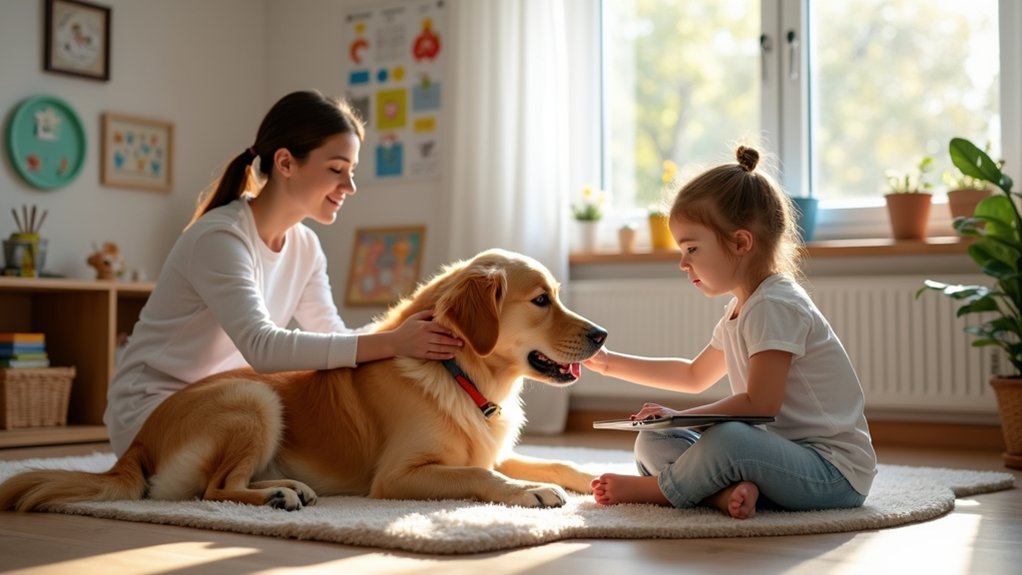For autism-friendly animal therapy programs: 1) Choose animals with calm temperaments that match specific therapeutic goals—dogs for communication, horses for motor skills, or small animals for sensory-sensitive children. 2) Structure sessions with visual schedules in low-distraction environments, typically running 8-12 weeks with hour-long weekly meetings. 3) Set measurable goals and track progress through consistent documentation and feedback. These foundational elements will set the stage for meaningful therapeutic connections between participants and animals.
Selecting the Right Therapy Animals for Autism Support

Numerous animals can provide therapeutic benefits for individuals with autism spectrum disorder (ASD), but selecting the right therapy animal requires careful consideration.
Focus on animals with calm temperaments that tolerate physical touch and respond consistently to handler commands.
Dogs excel at fostering communication and emotional regulation through close bonding, while service dogs specifically support safety monitoring and routine adherence.
For motor skill development, consider equine therapy which reduces irritability while improving social cognition.
Classroom settings benefit from smaller animals like guinea pigs that encourage nurturing behaviors without overwhelming sensory-sensitive children.
Always match the animal to your specific therapeutic goals—whether improving verbal skills, enhancing social interaction, or developing motor function.
Ensure any chosen animal undergoes regular health screening and receives adequate downtime to maintain both participant safety and animal welfare.
Research indicates therapy dogs may produce a calming effect on children with ASD, potentially reducing hyperactivity but also limiting physical activity during sessions.
Creating Structured Yet Flexible Animal Interaction Sessions
Effective animal interaction sessions for individuals with autism require careful balance between predictable structure and necessary flexibility.
Design sessions lasting about an hour, typically scheduled weekly over 8-12 weeks, with goal-oriented activities tailored to your participant’s needs.
Use visual schedules to help participants understand the session flow while incorporating their interests to enhance engagement.
Implement a “just right challenge” approach—activities that aren’t overwhelming but still provide growth opportunities.
You’ll need to adapt activities based on participant responses, monitoring progress regularly to guarantee effectiveness.
Create a positive environment using the animal’s calming presence to reduce anxiety and build trust.
Always conduct sessions in comfortable, low-distraction settings under professional supervision, with therapy animals that are specifically trained for these interactions. Consider using golden retrievers or other gentle breeds as they are popular therapy dogs known for their supportive and patient nature with children who have autism spectrum disorder.
Measuring Progress and Adapting Animal Therapy Approaches

With a structured program in place, your focus shifts to monitoring outcomes and refining your approach. Establish clear, measurable goals for your animal therapy sessions, specifically targeting social communication and stress reduction.
Track progress using multiple methods: behavioral observations, standardized assessments, and regular feedback from participants and families. Consider using specialized software or apps designed for therapy settings to document changes consistently. Graphing the collected data provides a visual representation of progress that helps evaluate the effectiveness of your animal therapy interventions.
Don’t hesitate to adapt your approach as needed. Combine animal therapy with other therapeutic models based on individual needs, and guarantee your therapists are trained in both AAT and traditional methods.
Use well-trained, certified therapy animals and maintain flexibility in your session structure.
Address challenges proactively by identifying barriers, providing ongoing training, and collaborating with other therapeutic services to complement your animal therapy program.
Frequently Asked Questions
How Do Insurance Companies Typically Cover Animal Therapy Costs?
Insurance companies typically don’t cover animal therapy costs. You’ll find most health plans exclude these services, though some rehabilitation centers may accept insurance for specific programs. Consider liability coverage and alternative funding options instead.
Can Siblings Participate in Animal Therapy Sessions?
Yes, siblings can participate in animal therapy sessions. You’ll find they often enhance the therapeutic experience by fostering family bonding, promoting shared experiences, and helping your child with ASD feel more comfortable and engaged.
What Safety Protocols Exist for Allergic Reactions During Therapy?
You’ll need emergency protocols with antihistamines on-site, staff trained in first aid, detailed medical history reviews, informed consent forms, and immediate evacuation plans. Always verify allergies before sessions and keep epinephrine auto-injectors available.
How Are Therapy Animals Cared for Between Sessions?
Between sessions, you’ll guarantee therapy animals receive mandatory rest periods in quiet environments. You’ll monitor their health, provide veterinary care, maintain proper nutrition, and offer enrichment activities. You’re responsible for their complete wellbeing and recovery time.
What Qualifications Should Animal Therapy Facilitators Possess?
You’ll need animal handling experience, understanding of animal behavior, strong communication skills, and relevant certifications. You should be at least 18, empathetic, able to design structured programs, and follow safety protocols.
In Summary
You’ll find that implementing these autism-friendly animal therapy practices transforms your program’s effectiveness. When you carefully select appropriate animals, structure sessions with necessary flexibility, and consistently measure outcomes to refine your approach, you’re creating meaningful connections. Don’t hesitate to adapt as you learn what works best for each individual. With thoughtful implementation, your animal therapy program will provide valuable support for those with autism.





Leave a Reply